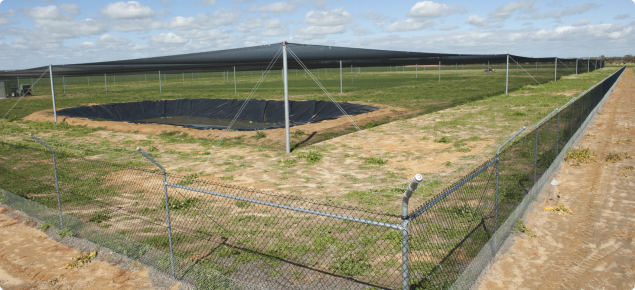Genetic modifications are playing an increasingly important role in crop science with greater areas being planted to genetically modified (GM) crops in over 25 countries worldwide, including Australia. GM may be adopted over conventional varieties for disease resistance or other unique characteristics that provide an advantage in our farming system or marketplace.
The aim of the New Genes for New Environments (NGNE) facilities at Merredin and Katanning is to accelerate the development of higher yielding, more resilient and nutrient efficient varieties, providing Western Australian grain growers with improved production efficiencies, ensuring they remain internationally competitive and profitable well into the future.
These locations were selected as they represent the lower and higher rainfall environments in WA. They also provide contrasting stresses such as low rainfall and high temperatures at Merredin with frost and winter waterlogging at Katanning.
Background to NGNE
New Genes for New Environments is a Department of Primary Industries and Regional Development (DPIRD) initiative designed to enable evaluation of the world’s best candidate GM traits from both public and private research organisations under Western Australian conditions in a highly contained and safe testing environment.
The WA State Government provided funding for the two state-of-the-art purpose built facilities and DPIRD provides ongoing technical and compliance support to users. The facilities enable the evaluation of GM plant traits under field conditions in two contrasting locations. These locations were selected as they represent the lower and higher rainfall environments of WA.
A major step in GM crop development is moving from the laboratory and glasshouse into the field. The NGNE initiative provides this capacity under containment arrangements that meet the stringent Australian standards of the Office of Gene Technology Regulator (OGTR).
The NGNE aim is to accelerate the development of higher yielding, more resilient and nutrient efficient varieties. This will help growers to enhance the internationally competitiveness and profitability of the WA agriculture industry.
NGNE services
- Assist in preparing regulatory requirements to OGTR for limited and controlled release for evaluation of GM traits in NGNE facilities.
- Contractual arrangement to evaluate company-owned GM crops in NGNE where DPIRD will be responsible for:
- Importation of GM seed through quarantine regulations.
- Preparing and managing field trials in NGNE, conducting and reporting trait measurements, harvesting trials and post-harvest monitoring.
- Quality assurance.
- Maintaining confidentiality, company IP stewardship and protection.
- Reporting as required by OGTR regulations.
- IP ownership remains with company - DPIRD has no interest in IP equity.
- Fee-for-service facility at a subsidised cost- minimal cost.
Working with us
Overview
The DPIRD NGNE facilities at Merredin and Katanning have been designed to enable private and public plant breeding and research organisations to evaluate GM breeding material and crops in accordance with the Office of the Gene Technology Regulator (OGTR ) licence conditions.
The OGTR has been established within the Australian Government Department of Health to provide administrative support to the Gene Technology Regulator in the performance of his functions under the Gene Technology Act 2000.
The Merredin and Katanning facilities are staffed by an NGNE compliance manager, a facilities manager and a project officer, who are collectively responsible for delivering contracted outputs to clients using the facilities.
What potential clients have to do to undertake research trials at NGNE
Steps to follow to start working at NGNE:
- Contact us to discuss your ideas.
- Do our facilities meet your needs?
- Check infrastructure (details below)
- Review locations (details below)
- It is important to understand the strict regulatory requirements for use of the NGNE facilities. For detailed information on the OGTR Licence Application and Assessment Process, visit the OGTR website and the DPIRD Institutional Biosafety Committee (IBC) page.
Infrastructure
NGNE has:
- A five hectare trial site enclosed by a two metre high fence to exclude large animals, bird-proof netting and a electronic security system.
- An onsite shed housing machinery dedicated to GM and seed production within the facility.
- A clean down pad - air and water pressure cleaners to ensure all equipment is thoroughly cleaned to further prevent GM material leaving the secured site.
- A physical containment level 2 (PC2) laboratory - fully equipped for analysis of GM plant material in a safe and contained environment, including an autoclave room for destruction of surplus viable plant materials.
- Staff - a full time project officer at each location
- GM crop trial work is overseen by a compliance manager.
Two different environments
NGNE facilities are located at Merredin and Katanning. These two sites have different climates and soils which enables trialling of GM crops in a variety of environments. These locations provide contrasting stresses such as low rainfall and high temperatures in Merredin with frost and winter waterlogging in Katanning. Below there is a summary of the environment at each site.
Merredin
Soils
- Yellow sands, sandy earths, gravels.
- Loamy earth and loamy duplex soils, both with calcareous subsoils.
Rainfall and temperature
The Merredin rainfall in the last 10 years has decreased in the winter months and increased in the summer period, compared to the last 30 years mean. The mean annual rainfall for Merredin for the last 10 years is 314mm and the growing season rainfall (May-October) is 203mm.
The graph below shows the mean maximum and minimum temperatures 2003-2012 and the mean rainfall for two periods (1983-2012 and 2003-2012) at Merredin.
Katanning
Soils
- Predominantly deep and shallow sandy duplex.
- Large proportion of subsoil being alkaline and sodic.
- Saline wet soil, alkaline grey shallow loamy duplex and duplex sandy gravels also common.
Rainfall and temperature
The Katanning rainfall in the last 10 years has decreased in the winter months and increased in the summer period, compared to the last 30 years mean. The mean annual rainfall for Katanning for the last 10 years is 419mm and the growing season rainfall (May-October) is 287mm.

